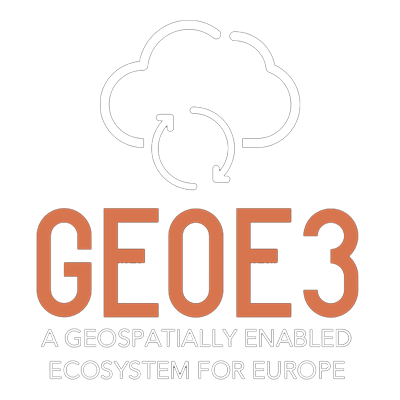Solar Energy
Investigation of the solar energy potential and energy efficiency of buildings based on detailed 3D building data, digital elevation models, climate normals, and forecasts.
Optimizing the heating and cooling system of a building
When designing a building, its heating and cooling facilities are planned in the context of the environmental effects (like exposure to sun and wind) at the building’s proposed geographical location.
Therefore, the architectural model must be available in a georeferenced form. The input datasets for the analysis on an adequate quality and harmonization level, and with permanent feature IDs for integration of external data, are available on the GeoE3 platform. They include
– 3D building model with LoD 2 detail
– digital Surface Model (DSM) of the surrounding area
– permeability info for the DSM
– shadow index coverage
– average wind conditions
– normal air temperature at the nearest observation station
– monthly mean temperature based on climate scenarios.
Analysis functions that GeoE3 provides support the user in performing the tasks of the use case.
An optimal plan of the heating/cooling facilities for the designed building considers the environment at the building site and the anticipated future effects of climate change.[PP3] Architectural planning is based on a real georeferenced model, where actual environmental factors and localized future climate scenarios can be considered.
Significant savings are achieved by optimizing the heating systems of the buildings. Reliable predictions of the necessary cooling facilities can also be made.
By expanding the planning area, an analysis can be made of the benefits a centralized heating/cooling facility might provide. The analysis might also be applied so that the exact location of the building in the target area is optimized to minimize the cost related to heating/cooling installations.
The optimal plan of the heating/cooling facilities for the designed building, considering the environment at the actual building site and the anticipated future effects of climate change on the location.
Analyzing the solar energy potential of a building
The solar energy potential of a building is evaluated by calculating how much solar radiation is available on the roof of the building. In this analysis, the following factors will be evaluated on the exact geographical location of the building:
– the form of the roof
– average sun inclination
– possible external shadowing objects (like neighboring buildings and major trees)
– prospects of future climate conditions.
The analysis can be applied in a cross-border manner.
The actor has a profound understanding of solar energy and all the required software and computing facilities for performing the analysis. The input datasets for the analysis, available from the GeoE3 platform, on an adequate quality and harmonization level, and with permanent feature IDs for integration of external data, including
– 3D building model with LoD 2 detail
– relevant building attributes
– digital Surface Model (DSM) of the surrounding area
– shadow index coverage
– number of sunshine hours at the nearest observation station.
Analysis functions that GeoE3 provides to support the user in performing the tasks of the use case.
A reliable result of the solar energy potential of the building in question can be achieved and the actor can apply the analysis independently of state borders.
The actors in the field can expand their businesses internationally. The best possible analysis methods are widely applied as a result of international competition.
The optimal number of solar panels is acquired and installed in the best possible locations. The effects of climate change are minimized. If 3D building models are not available, an approximate analysis can be run on DSM data alone. Considering the permeability and steadiness of the shadowing object in DSM (whether building or forest/tree) would improve the analysis.
Smart Cities
These application cases are concerned with the expansion of urban land. The use case has been divided into two parts: one on renewable energy potential where a planned development area is considered. The second deals with the optimization of the efficiency of urban expansion using the United Nations Sustainable Development Goal (SDG) indicator 11.3.1 as the measure.
Cross border & Cross domain Smart City Finland Estonia
The use case has been divided into two parts: in use case 3A the renewable energy potential of a planned development area is considered. Use case 3B deals with the optimization of the efficiency of urban expansion using the United Nations Sustainable Development Goal (SDG) indicator 11.3.1 as the measure.
Renewable Energy Potential
Solar and wind energy potential of planned development is evaluated, based on spatial analysis with a rough 3D construction plan, together with the actual geographic model of the target area for City Planning Departments.
The planned development has to be available as rough georeferenced 3D volumes with approximate roof models (LoD 2). The input datasets for the analysis, available from the GeoE3 platform, on an adequate quality and harmonization level, and with permanent feature IDs for integration of external data:
– High-resolution Digital Elevation Model (DEM)
– Digital Surface Model (DSM)
– Average wind conditions
– Number of sunshine hours at the nearest observation station
– Wind speed normal at the nearest observation station
Analysis functions that GeoE3 provides to support the user in performing the tasks of the use case.
New development areas are selected in a more energy-efficient way. Significant savings can be attained for the city, as the need for the provision of centralized energy sources is decreased.
Energy consumption in the newly developed areas is kept to a minimum. With the increased provision of renewable energy sources, the effects of climate change can be restrained. The availability of a city model of the surrounding areas would improve the analysis. The analysis can also support the planning of centralized energy production facilities and energy distribution networks. The analysis can be extended to cover cross-border target areas.
Analyzing the efficiency of expansion of urban land
The efficiency of an urban expansion plan is evaluated by analyzing the compactness of the new development. The measure to be used is the ratio between land consumption and population growth in the development area (UN SDG indicator 11.3.1). A comparison is made between the 11.3.1 indicator of the area before and after the planned expansion with respect to regional councils.
Expansion plans have to be available with estimates of land consumption and predicted population capacity. The input datasets for the analysis, available from the GeoE3 platform, on an adequate quality and harmonization level, and with permanent feature IDs for integration of external data:
Building footprints
Existing population data
Analysis functions that GeoE3 provides to support the user in performing the tasks of the use case.
Regional planning is based on reliable facts on the efficiency of the planned developments, compared with the existing situation in the target area.
Urban areas can be expanded in a sustainable way.
More relevant data (like statistics information) can be attached to the existing building features if deemed necessary. The analysis can also be applied for comparison between alternative expansion plans. The 11.3.1 indicator for a given area might also be readily available from the GeoE3 platform. The analysis can be extended to cover cross-border target areas.
Electric cars
Evaluation and prediction of the energy consumption of electric cars. These will be based on 2D and 3D road data, weather and traffic data, road signs, and speed limits.
Co-operative Intelligent Transport Systems (C-ITS) and Advancing map-enhanced driver assistance systems leading to automated driving (ADASIS)
The second use case combines data from GeoE3 with other public open data to provide new services for the European C-ITS platform (Cooperative Intelligent Transport Systems) as illustrated in this figure.

This solution will provide 3D geospatial data for electric vehicles with a need to calculate how much power they will use to reach the top of a mountain pass, and how much they can recharge the batteries when they descend the mountain on the other side. It will also be useful as part of the ADAS (Automated Driver Assist System) in heavy goods vehicles (HGV), where the cruise control can take into account upcoming slopes and sharp curves on the road before shifting gear. In addition, we will provide traffic signs and speed limits to the vehicles, collected from the NVDB databases found in Norway and Finland, as well as traffic alerts from the DATEX2 servers and weather alerts from the meteorological services.
Providers of C-ITS and ADASIS services like road operators, fleet management systems, and navigation systems. The actors have backend systems that communicate with the vehicles either according to the C-ITS standards or the ADASIS specifications. Optimize trip planning to minimize energy/fuel usage, avoid trouble, and reduce travel time. Cost savings from reduced energy/fuel usage and reduced travel time outweigh the costs of implementing and maintaining this solution. Include automatic booking of ferries, booking of charging/fueling stations, and booking of rest stops as part of the trip planning.


